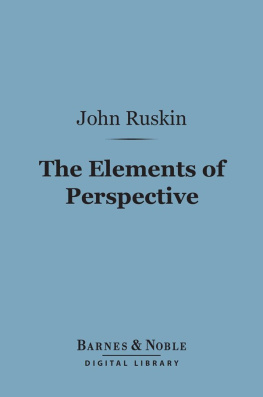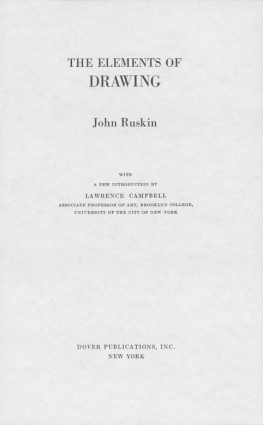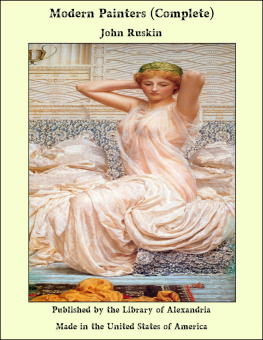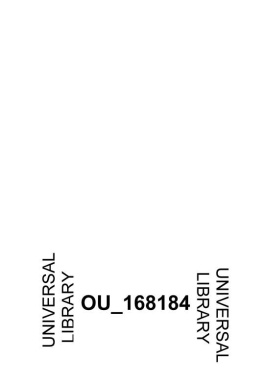This 2011 edition published by Barnes & Noble, Inc.
All rights reserved. No part of this publication may be reproduced, stored in a retrieval system, or transmitted, in any form or by any means, electronic, mechanical, photocopying, recording, or otherwise, without prior written permission from the publisher.
Barnes & Noble, Inc.
122 Fifth Avenue
New York, NY 10011
ISBN: 978-1-4114-5066-0
PREFACE
F OR some time back I have felt the want, among Students of Drawing, of a written code of accurate Perspective Law; the modes of construction in common use being various, and, for some problems, insufficient. It would have been desirable to draw up such a code in popular language, so as to do away with the most repulsive difficulties of the subject; but finding this popularization would be impossible, without elaborate figures and long explanations, such as I had no leisure to prepare, I have arranged the necessary rules in a short mathematical form, which any schoolboy may read through in a few days, after he has mastered the first three and the sixth books of Euclid.
Some awkward compromises have been admitted between the first-attempted popular explanation, and the severer arrangement, involving irregular lettering and redundant phraseology; but I cannot for the present do more, and leave the book therefore to its trial, hoping that, if it be found by masters of schools to answer its purpose, I may here after bring it into better form.
An account of practical methods, sufficient for general purposes of sketching, might indeed have been set down in much less space, but if the student reads the following pages carefully, he will not only find himself able, on occasion, to solve perspective problems of a complexity greater than the ordinary rules will reach, but obtain a clue to many important laws of pictorial effect, no less than of outline. The subject thus examined becomes, at least to my mind, very curious and interesting; but, for students who are unable or unwilling to take it up in this abstract form, I believe good help will be soon furnished, in a series of illustrations of practical perspective now in preparation by Mr. Le Vengeur. I have not seen this essay in an advanced state, but the illustrations shown to me were very clear and good; and as the author has devoted much thought to their arrangement, I hope that his work will be precisely what is wanted by the general learner.
Students wishing to pursue the subject into its more extended branches will find, I believe, Cloquet's treatise the best hitherto published.
CONTENTS
PROBLEM I
PROBLEM II
PROBLEM III
PROBLEM IV
PROBLEM V
PROBLEM VI
PROBLEM VII
PROBLEM VIII
PROBLEM IX
PROBLEM X
PROBLEM XI
PROBLEM XII
PROBLEM XIII
PROBLEM XIV
PROBLEM XV
PROBLEM XVI
PROBLEM XVII
PROBLEM XVIII
PROBLEM XIX
PROBLEM XX
APPENDIX
I
II
INTRODUCTION
W HEN you begin to read this book, sit down very near the window, and shut the window. I hope the view out of it is pretty; but, whatever the view may be, we shall find enough in it for an illustration of the first principles of perspective (or, literally, of "looking through").
Every pane of your window may be considered, if you choose, as a glass picture; and what you see through it, as painted on its surface.
And if, holding your head still, you extend your hand to the glass, you may, with a brush full of any thick colour, trace, roughly, the lines of the landscape on the glass.
But, to do this, you must hold your head very still. Not only you must not move it sideways, nor up and down, but it must not even move backwards or forwards; for, if you move your head forwards, you will see more of the landscape through the pane and, if you move it backwards, you will see less: or considering the pane of glass as a picture, when you hold your head near it, the objects are painted small, and a great many of them go into a little space; but, when you hold your head some distance back, the objects are painted larger upon the pane, and fewer of them go into the field of it.
But, besides holding your head still, you must, when you try to trace the picture on the glass, shut one of your eyes. If you do not, the point of the brush appears double; and, on farther experiment, you will observe that each of your eyes sees the object in a different place on the glass, so that the tracing which is true to the sight of the right eye is a couple of inches (or more, according to your distance from the pane), to the left of that which is true to the sight of the left.
Thus, it is only possible to draw what you see through the window rightly on the surface of the glass, by fixing one eye at a given point, and neither moving it to the right nor left nor up nor on which the objects seen through it have been thus drawn. Perspective can, therefore, only be quite right, by being calculated for one fixed position of the eye of the observer; nor will it ever appear deceptively right unless seen precisely from the point it is calculated for. Custom, however, enables us to feel the rightness of the work on using both our eyes, and to be satisfied with it, even when we stand at some distance from the point it is designed for.
Supposing that, instead of a window, an unbroken plate of crystal extended itself to the right and left of you, and high in front, and that you had a brush as long as you wanted (a mile long, suppose), and could paint with such a brush, then the clouds high up, nearly over your head, and the landscape far away to the right and left, might the picture very large: vice versa, if you place the point of observation far from the canvass, you should not make it very small; the fixing, therefore, of this point of observation determines, as a matter of convenience, within certain limits, the size of your picture. But it does not determine this size by any perspective law; and it is a mistake made by many writers on perspective, to connect some of their rules definitely with the size of the picture. For, suppose that you had what you now see through your window painted actually upon its surface, it would be quite optional to cut out any piece you chose, with the piece of the landscape that was painted on it. You might have only half a pane, with a single tree; or a whole pane, with two trees and a cottage; or two panes with the whole farmyard and pond; or four panes, with farmyard, pond, and foreground. And any of these pieces, if the landscape upon them were, as a scene, pleasantly composed, would be agreeable pictures, though of quite different sizes; and yet they would be all calculated for the same distance of observation.
In the following treatise, therefore, I keep the size of the picture entirely undetermined. I consider the field of canvass as wholly unlimited, and on that condition determine the perspective laws. After we know how to apply those laws without limitation, we shall see what limitations of the size of the picture their results may render advisable.
But although the size of the picture is thus independent of the observer's distance, the size of the object represented in the picture is not. On the contrary, that size is fixed by absolute mathematical law; that is to say, supposing you have to draw a tower a hundred feet high, and a quarter of a mile distant from you, the height which you ought to give that tower on your paper depends, with mathematical precision, on the distance at which you intend your paper to be placed. So, also, do all the rules for drawing the form of the tower, whatever it may be.
Hence, the first thing to be done in beginning a drawing is to fix, at your choice, this distance of observation, or the distance at which you mean to stand from your paper. After that is determined, all is determined, except only the ultimate size of your picture, which you may make greater, or less, not by altering the size of the things represented, but by
Next page











